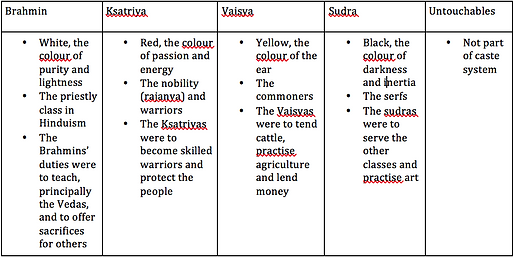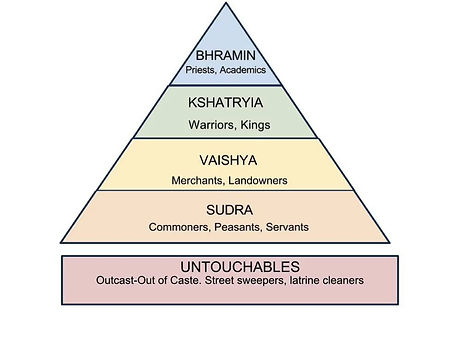
THE INTERNAL STRUCTURE IN HINDUISM
THE CASTE SYSTEM
-
India’s caste system is a system of social stratification on the basis of ritual purity; its nature rooted in religion and is an integral aspect of Hinduism.
-
The caste or varna system is mentioned in Hindu scriptures and texts such as the Rig Veda and in the Gita.
-
Varna refers to a system of colour symbolism reflecting a social hierarchy.
-
The Purusha Sukta in the 10th Mandala of the Rig Veda describes how castes came into existence, from different parts of Purusha, the Cosmic Soul, at the time of a grand sacrifice performed by the gods. The Brahmins came out of his mouth, the Kshatriyas from his arms, the vaisyas from his thighs and the sudras from his feet.
-
The varna dictates the type of occupations a person can pursue and the social interactions that they may have
-
Differences in status are traditionally justified by the religious doctrine of karma, a belief that one’s place in life is determined by one’s deeds in previous lifetimes. Whilst legislation such as Scheduled Caste and Scheduled Tribes (Prevention of atrocities) Act 1989, bans discrimination based on caste, the caste system still operates within rural areas, whereby castes strictly limit occupational mobility and social interactions.
-
Dalit men, women and children (whom are identified as the ‘untouchables,’) are forbidden by caste Hindus to enter places of worship, to draw from public wells or to wear shoes in a caste Hindus presence, as they are deemed as polluting
-
Brahmin priests reinforce their status through chanting the Rig Veda and Yajur Veda during sanskara (rites of passage) such as weddings an funerals, which traditionally, were created to be chanted by Brahmin priests during sacrifices
-
Traditionally, marriage was endogamous between castes, and is sometimes considered amongst the match-making process in contemporary India

